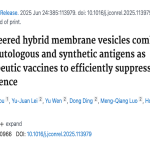
Patel, N., et al. Single-dose avian influenza A(H5N1) Clade 2.3.4.4b hemagglutinin-Matrix-M® nanoparticle vaccine induces neutralizing responses in nonhuman primates. Nat Commun, 2025 Jul 18, 16(1):6625.
Patel, N., et al. Single-dose avian influenza A(H5N1) Clade 2.3.4.4b hemagglutinin-Matrix-M® nanoparticle vaccine induces neutralizing responses in nonhuman primates. Nat Commun, 2025 Jul 18, 16(1):6625. PMID: 40681543
- This study highlights the role of saponins derived from the Quillaja saponaria Molina tree, which are a key component of the Matrix-M adjuvant used in the H5-MNP vaccine.
- The saponins facilitate the formation of cage-like nanoparticle structures by non-covalently anchoring recombinant full-length HA trimers through interactions with lipid and cholesterol components, promoting efficient co-delivery and presentation of antigen. Additionally, the saponins contribute to endosomal disruption within antigen-presenting cells, enabling antigen release into the cytoplasm, thereby enhancing MHC I presentation and inducing robust CD8+ T-cell responses. This dual role of saponins in both nanoparticle assembly and immune activation underscores their importance in augmenting vaccine immunogenicity against H5N1 influenza.
- In conclusion, saponins from Quillaja saponaria Molina are integral to the design and efficacy of the H5-MNP vaccine, serving both as a structural component that facilitates nanoparticle formation through non-covalent anchoring of HA trimers and as an immune stimulator that promotes endosomal disruption and antigen presentation. Their ability to enhance both humoral and cellular immune responses, including CD8+ T-cell activation, underscores their vital role in advancing effective influenza vaccines against emerging HPAI strains. This dual functionality demonstrates the potential of saponins as powerful adjuvants in next-generation vaccine formulations.
Click here to access the full scientific paper.
Recent Posts




